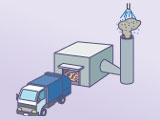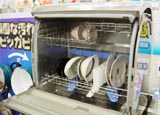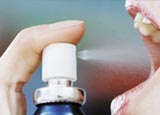
 |
||
| Member Login
| FAQ
| Terms of Use & Browser Requirements
| Contact Us
| Japanese |
||

| Support Tools | Nozzle World: Introduction | Nozzle World: Practical Edition | Glossary | Unit Converter | Search Code No. Converter |
|
Edited by Nozzle Network Co., Ltd.
 Nozzles in electric vehicle R&D Nozzles in electric vehicle R&DWith the aim of protecting the global environment in the 21st century, the world's automobile manufacturers are striving to develop cars that do not pollute the atmosphere as gasoline powered cars do today. The most promising new technology is the fuel cell. Fuel cell powered vehicles emit no exhaust gases whatsoever. Various kinds of nozzles are being developed to increase fuel cell efficiency, and as components of fuel cells, there is likely to be a future demand for tens of millions of nozzles annually.  Nozzles clean up diesel engine emissions Nozzles clean up diesel engine emissionsEmissions from diesel vehicles—visible as black smoke—are one of the major causes of photochemical smog and acid rain. Some countries have already taken measures to address this problem; new legal controls are being introduced, and consequently many research forums are promoting investigation into ways of neutralizing these emissions by means of spraying. Nozzles will, therefore, play an important role in cleaning up exhaust emissions and protecting human health. Mobile phones, computers, and other electronic devices that we use every day rely upon semiconductors. Nozzles are employed in a number of the processes that are required to produce semiconductors, including micro-cleaning, spraying of developer, etching and alkali washing of lead frames and print substrate, and shadow mask etching.  Atomizing nozzles help to give cars a beautiful finish Atomizing nozzles help to give cars a beautiful finishAs a car body moves along a factory production line, nozzles spray detergent solution to rinse off oil and dirt, then air to dry the cleaned surfaces. The gleaming and perfectly uniform paintwork of today's cars is achieved by spraying body panels with fine particles of coating. High precision atomizing nozzles make this possible.  Super-precision nozzles in the manufacture of microencapsulated medicines Super-precision nozzles in the manufacture of microencapsulated medicinesMicrocapsules are tiny granules of medicines that have been encapsulated in a solid shell in order to control where inside the body the medicine will be released. Microcapsules can be designed to dissolve in the mouth, stomach, or gut, and can be smaller in size than the tip of a needle. The point of absorption of the medicine, in accordance the purpose of the treatment, is controlled by the thickness of the shell. It is a nozzle, dispensing the coating material with super-precision, which determines this crucial shell thickness.  Nozzles remove toxins from garbage incinerator gases Nozzles remove toxins from garbage incinerator gasesMany garbage incinerators are located in urban areas. When household waste, which often contains vinyl chloride, plastics, etc., is burnt in these incinerators, a variety of harmful gases are produced. These gases, of which dioxin is the most toxic, are extremely hazardous to human health. Water or treating liquid, sprayed via nozzles onto the gases, prevents these toxic chemicals from escaping into the atmosphere, thereby protecting human health.  Mist produced by nozzles removes static electricity, prevents accidents Mist produced by nozzles removes static electricity, prevents accidentsStatic electricity—responsible for the shocks we sometimes feel when taking off a sweater or touching a car door—can cause major problems and even serious accidents in industrial settings. When, as a result of static electricity, sparks occur inside a factory in which flammable fluid is in use, fire can ensue. This static can be eliminated by humidification, the humidification being produced with the help of nozzles. |
| Support Tools | Nozzle World: Introduction | Nozzle World: Practical Edition | Glossary | Unit Converter | Search Code No. Converter | ||
|
Support Tools
| Site Policy
| Site Map
| Service Provider Copyright© Nozzle Network Co., Ltd. All Rights Reserved.
|
||


